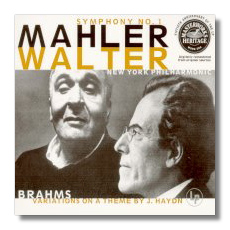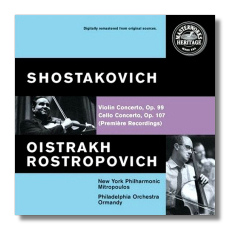
The Internet's Premier Classical Music Source
Related Links
-
Brahms Reviews
Dvořák Reviews
Mahler Reviews
Shostakovich Reviews
Smetana Reviews - Latest Reviews
- More Reviews
-
By Composer
-
Collections
DVD & Blu-ray
Books
Concert Reviews
Articles/Interviews
Software
Audio
Search Amazon
Recommended Links
Site News
 CD Review
CD Review
Sony Masterworks Heritage

- Gustav Mahler:
- Symphony #1 in D Major (1888)
- Johannes Brahms:
- Variations on a Theme by Haydn, Op. 56a (1873)
New York Philharmonic Orchestra/Bruno Walter
Sony Classical MHK63328 ADD mono 65:15


Dmitri Shostakovich
- Concerto for Violin #1 in A minor, Op. 77 (1955)
- Concerto for Cello #1 in E Flat Major, Op. 107 (1959)
David Oistrakh, violin
Mstislav Rostropovich, cello
New York Philharmonic Orchestra/Dimitri Mitropoulos Philadelphia Orchestra/Eugene Ormandy
Sony Classical MHK63327 ADD mono/stereo 63:46


- Antonín Dvořák:
- Symphony #7 in D minor, Op. 70 (1885)
- Symphony #8 in G Major, Op. 88 (1889)
- Symphony #9 in E minor "From The New World", Op. 95 (1893)
- Overture "Carnival", Op. 92 (1891)
- Bedřich Smetana:
- The Bartered Bride Overture (1866)
- String Quartet #1 in E minor "From My Life" (1876)
Cleveland Orchestra/George Szell
Sony Classical MH2K63151 ADD mono/stereo 2CDs 79:29, 75:23
Because of his personal association with the composer, it is good that we have examples of Bruno Walter's Mahler on record. It is less good that Gustav Mahler had been dead for decades before Walter committed most of his interpretations to disc, so it would be naïve to assume that there is anything definitive about Walter's recordings, at least in the sense of composer-sanctioned. (Indeed, the composer's musically-savvy wife endorsed William Steinberg's recording of Mahler's First – EMI Classics CDM66555, with the Pittsburgh Symphony Orchestra.)
Columbia (and Sony) have reissued Mahler's later Mahler First (with the Columbia Symphony Orchestra) many times. It's a great performance, but I like this earlier one better. It was recorded in 1954, while the conductor still was holding a regular position (shared, more or less, with Dimitri Mitropoulos and Leonard Bernstein) with the New York Philharmonic. Bernstein was the conductor who brought a neurotic Mahler into modern times, but Walter would have none of that. This recording, even more than its successor, is strong and unsentimental, and, tellingly, one of the few Mahler Firsts to have a playing time of less than fifty minutes. Another advantage of this New York recording is the heft of the orchestral sound, and the star playing of the orchestra's musicians, individually and as a unit. Don't let the mono sound deter you; audiophiles continue to warm to the original LP, and its best qualities have been transferred to CD by the reissue engineers.
The "filler" is a heart-warming recording of the Brahms "Haydn" Variations, recorded in Carnegie Hall the previous winter. This interpretation is pervaded by serene gemutlichkeit, particularly in the seventh variation, which has an unpretentious simplicity that artfully belies the musicians' hard work.
The Shostakovich disc is of historical importance because it contains the première recordings of two major works: the better of his two violin concertos, and the worse of his two cello concertos. The former was recorded on January 2, 1956, at the end of Oistrakh's first appearances in the United States. At that time, he was the only person to have played the concerto. Mitropoulos already had established himself as a strong advocate for Shostakovich through performances and recordings of the Fifth and Tenth Symphonies.
Clearly, the cards were stacked in favor of a nearly ideal realization of Shostakovich's dark concerto. And so it is, although I have a few reservations. The recorded balance favors Oistrakh, but it is Mitropoulos of whom I want to hear more; he sets up a cold and lonely ambience that seems to be the Iron Curtain in notes. I think Oistrakh hesitates to paint the concerto's most horrible colors; after all, he had a career to continue back in the Soviet Union, and, during the American trip, his Soviet entourage was watchful. Still, the only other recording I like this well is played by Nell Gotkovsky (Pyramid), and her Bulgarian orchestra certainly is not the New York Philharmonic.
Shostakovich was present at the Cello Concerto's recording sessions. (The First Symphony was recorded at this time as well.) Session photos show him, Rostropovich, and Ormandy in high spirits, but as with Walter's Mahler, one must be careful about accepting the results as definitive, good as they are. The Philadelphia sound is plush, the opposite of what one might prescribe for Shostakovich, and the interpretation – much like Oistrakh's in the First Violin Concerto – stops short of peering deeply into the wild abyss. But, I confess that this is a work that never quite satisfies me, so the fault might not be in the performers. The stereo recording has transferred very well to CD. For brassheads, Mason Jones' horn solos alone are worth the cost of this disc.
Both of the above releases celebrate the fiftieth anniversary of the long-playing record. Yippee!
The word most frequently used to describe Hungarian-born conductor George Szell is "perfectionist." He was not above using intimidation to get what he wanted, and music would be rehearsed over and over again until he was satisfied – no Beecham-like casualness for him. It is as if one multi-talented musician were playing all the parts. His recordings with the Cleveland Orchestra have remained in print for most of the past three to four decades, probably because they demonstrate such a high level of discipline. This discipline, rather than stifling the music, electrifies it.
It is good to have Szell's dynamic Dvořák back on disc, because it possessed all the qualities mentioned above. The symphonies were recorded for the Epic label in 1958-60 in "Stereorama," which is a whole lot better than it might sound; in fact, thanks to Sony's remastering, the sonics now are of demonstration quality. As for the performances, time and again Szell uncovers details of phrasing and scoring that many conductors miss. And, even though he realizes all of Dvořák's details, he maintains the Big Line, allowing the music to sweep irresistibly forward.
The overtures, recorded in 1958 (The Bartered Bride) and 1963 (Carnival), are similarly fine, and will be familiar to many older collectors. This two-CD set's striking novelty, however, is a monaural recording made in 1949: Smetana's E Minor String Quartet, subtitled "From my Life." Szell orchestrated the quartet earlier in that decade when he first came to the United States and was without regular work. The quartet is autobiographical, telling of Smetana's passions (musical and otherwise), hopes, and, in the final movement, deafness: a shrill E in the violins represents his tinnitus. Szell's orchestration has not been taken up by the musical establishment. Too bad, because it is both masterful and idiomatic – one could believe that Smetana originally wrote the music just this way. Szell and the Cleveland Orchestra play it in a sort of focused white heat, and it makes for a very gripping musical experience, one that is both dramatic and pathetic. It is possible to find the 10-inch LP here and there, but get this CD: the sound is astonishingly good, and you shouldn't deny yourself this musical treat any longer than is necessary.
All three releases are in Sony's superb Masterworks Heritage series. The absence of traditional jewel boxes makes the releases look more like little books, on whose covers the original cover art has been preserved, and on whose interiors every effort has been made to recreate the feel of an LP record.
Copyright © 1999, Raymond Tuttle





















